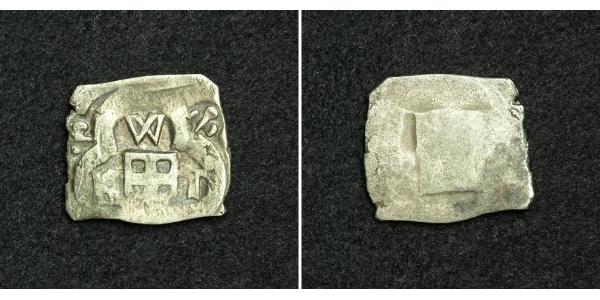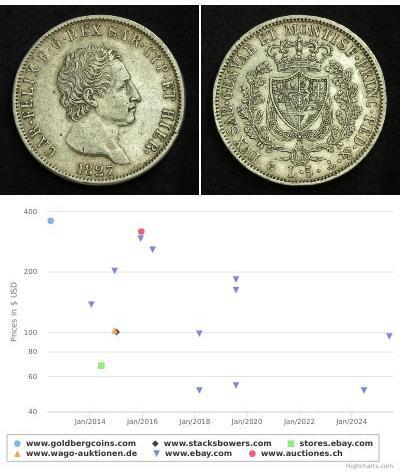(sold for $10.0)
1460, Vienna, Emperor Frederick III "the Peaceful". Silver Pfennig Coin. VF+
Condition: VF+
Mint Place: Vienna.
Mint Master: Teschler
Reference: CNA Fa 13.
Mint Period: around 1460
Denomination: Uniface Pfennig (2pcs)
Diameter: 14mm
Material: Silver
Weight: 0.58gm
Obverse: Shield with Vinnese arms (cross) surrounded by initials (WHT). All within trefoil with lis symbols in outer fields.
Legend: W-H-T- ("Wiener Hausgenossen Teschler" = "Viennese Mint Workers / Teschler (as Mint Master)")
Reverse: Blank (as expected for this uniface type)
For your consderation a scarce uniface pfennig coin, struck in Vienna around 1460 by Nikolaus Teschler as mint master and the Viennese Mint Workers ("Wiener Hausgenossen") , under the reign of Albert II of Habsburg.
Frederick the Peaceful KG (September 21, 1415 – August 19, 1493) was Duke of Austria as Frederick V from 1424, the successor of Albert II as German King as Frederick IV from 1440, and Holy Roman Emperor as Frederick III from 1452. In 1493, he was succeeded by his son Maximilian I after ten years of joint rule.
Born in Innsbruck, he was the son of Duke Ernest the Iron of the Leopoldinian line of the Habsburg family, the ruler of Inner Austria, i.e. the duchies of Styria, Carinthia and Carniola, and of Ernest's wife Cymburgis of Masovia. He became duke of Inner Austria as Frederick V upon his father's death in 1424.
In 1440 he was elected German king as Frederick IV and in 1452 crowned Holy Roman Emperor as Frederick III by Pope Nicholas V. In 1452, at the age of 37, he married the 18-year-old Infanta Eleanor, daughter of King Edward of Portugal, whose dowry helped him to alleviate his debts and cement his power.
In 1442, Frederick allied himself with Rudolf Stüssi, burgomaster of Zürich, against the Old Swiss Confederacy in the Old Zürich War (Alter Zürichkrieg).
In 1448, he entered into the Vienna Concordat with the Holy See, which remained in force until 1806 and regulated the relationship between the Habsburgs and the Holy See.
Frederick was the last Emperor to be crowned in Rome. He opposed the reform of the Holy Roman Empire at that time and was barely able to prevent the electors from electing another king.
Frederick's style of rulership was marked by hesitation and a sluggish pace of decision making. The Italian humanist Enea Silvio Piccolomini, later Pope Pius II, who at one time worked at Frederick's court, described the Emperor as a person who wanted to conquer the world while remaining seated. Although this was regarded as a character flaw in older academic research, his delaying tactics are now viewed as a means of coping with political challenges in far-flung territorial possessions. Frederick is credited with having the ability to sit out difficult political situations patiently.
According to contemporary accounts, Frederick had difficulties developing emotional closeness to other persons, including his children and wife Eleanor. In general, Frederick kept himself away from women, the reasons for which are not known. As Frederick was rather distant to his family, Eleanor had a great influence on the raising and education of Frederick's children, and she therefore played an important role in the House of Habsburg's rise to prominence.
Frederick's political initiatives were hardly bold, but they were still successful. His first major opponent was his brother Albert VI, who challenged his rule. He did not manage to win a single conflict on the battlefield against him, and thus resorted to more subtle means. He held his second cousin once removed Ladislaus the Posthumous, the ruler of the Archduchy of Austria, Hungary and Bohemia, (born in 1440) as a prisoner and attempted to extend his guardianship over him in perpetuity to maintain his control over Lower Austria. Ladislaus was freed in 1452 by the Lower Austrian estates. He acted similarly towards his nephew Sigismund of the Tyrolian line of the Habsburg family. Despite those efforts, he failed to gain control over Hungary and Bohemia, and was even defeated by the Hungarian King Matthias Corvinus in 1485, who managed to maintain residence in Vienna until his death five years later. Ultimately, Frederick prevailed in all those conflicts by outliving his opponents and sometimes inheriting their lands, as was the case with his nephew Ladislaus, from whom he gained Lower Austria in 1457, and with his brother Albert VI, whom he succeeded in Upper Austria. These conflicts forced him into an anachronistic itinerant existence, as he had to move his court between various places through the years, residing in Graz, Linz and Wiener Neustadt. Wiener Neustadt owes him its castle and the "New Monastery".
Still, in some ways his policies were astonishingly successful. In the Siege of Neuss (1474–75), he forced Charles the Bold of Burgundy to give up his daughter Mary of Burgundy as wife to Frederick's son Maximilian. With the inheritance of Burgundy, the House of Habsburg began to rise to predominance in Europe. This gave rise to the saying "Let others wage wars, but you, happy Austria, shall marry", which became a motto of the dynasty.
The marriage of his daughter Kunigunde of Austria to Albert IV, Duke of Bavaria, was another result of intrigues and deception, but must be counted as a defeat for Frederick. Albert illegally took control of some imperial fiefs and then asked to marry Kunigunde (who lived in Innsbruck, far from her father), offering to give her the fiefs as a dowry. Frederick agreed at first, but after Albert took over yet another fief, Regensburg, Frederick withdrew his consent. On January 2, 1487, however, before Frederick's change of heart could be communicated to his daughter, Kunigunde married Albert. A war was prevented only through the mediation of the Emperor's son, Maximilian.
In some smaller matters, Frederick was quite successful: in 1469 he managed to establish bishoprics in Vienna and Wiener Neustadt, a step that no previous Duke of Austria had been able to achieve.
Frederick's personal motto was the mysterious string A.E.I.O.U., which he imprinted on all his belongings. He never explained its meaning, leading to many different interpretations being presented, although it has been claimed that shortly before his death he said it stands for Alles Erdreich ist Österreich untertan (English: All the world is subject to Austria.) It may well symbolise his own understanding of the historical importance and meaning of his rule and of the early gaining of the Imperial title.
At the age of 77, Frederick III died at Linz when the amputation of his left leg caused him to bleed to death. His grave, built by Nikolaus Gerhaert von Leyden, in the Stephansdom in Vienna, is one of the most important works of sculptural art of the late Middle Ages. His amputed leg was buried with him.
For the last ten years of Frederick's life, he and Maximilian ruled jointly.

|
Posted by:
anonymous 2014-06-30 |
990 coins were uploaded from 2025-05-21 to 2025-05-28
One of them is:






















